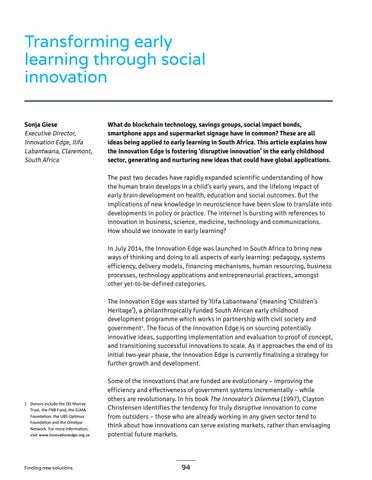Transforming early learning through social innovation Sonja Giese Executive Director, Innovation Edge, Ilifa Labantwana, Claremont, South Africa
What do blockchain technology, savings groups, social impact bonds, smartphone apps and supermarket signage have in common? These are all ideas being applied to early learning in South Africa. This article explains how the Innovation Edge is fostering ‘disruptive innovation’ in the early childhood sector, generating and nurturing new ideas that could have global applications. The past two decades have rapidly expanded scientific understanding of how the human brain develops in a child’s early years, and the lifelong impact of early brain development on health, education and social outcomes. But the implications of new knowledge in neuroscience have been slow to translate into developments in policy or practice. The internet is bursting with references to innovation in business, science, medicine, technology and communications. How should we innovate in early learning? In July 2014, the Innovation Edge was launched in South Africa to bring new ways of thinking and doing to all aspects of early learning: pedagogy, systems efficiency, delivery models, financing mechanisms, human resourcing, business processes, technology applications and entrepreneurial practices, amongst other yet-to-be-defined categories. The Innovation Edge was started by ‘Ilifa Labantwana’ (meaning ‘Children’s Heritage’), a philanthropically funded South African early childhood development programme which works in partnership with civil society and government1. The focus of the Innovation Edge is on sourcing potentially innovative ideas, supporting implementation and evaluation to proof of concept, and transitioning successful innovations to scale. As it approaches the end of its initial two-year phase, the Innovation Edge is currently finalising a strategy for further growth and development.
1 Donors include the DG Murray Trust, the FNB Fund, the ELMA Foundation, the UBS Optimus Foundation and the Omidyar Network. For more information, visit www.innovationedge.org.za
Finding new solutions
Some of the innovations that are funded are evolutionary – improving the efficiency and effectiveness of government systems incrementally – while others are revolutionary. In his book The Innovator’s Dilemma (1997), Clayton Christensen identifies the tendency for truly disruptive innovation to come from outsiders – those who are already working in any given sector tend to think about how innovations can serve existing markets, rather than envisaging potential future markets.
94
